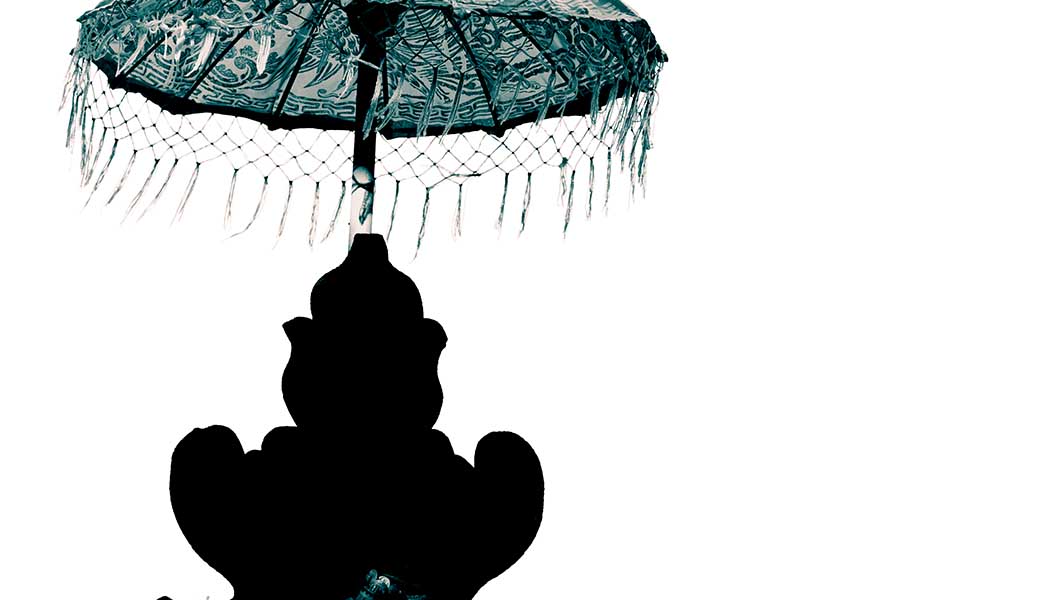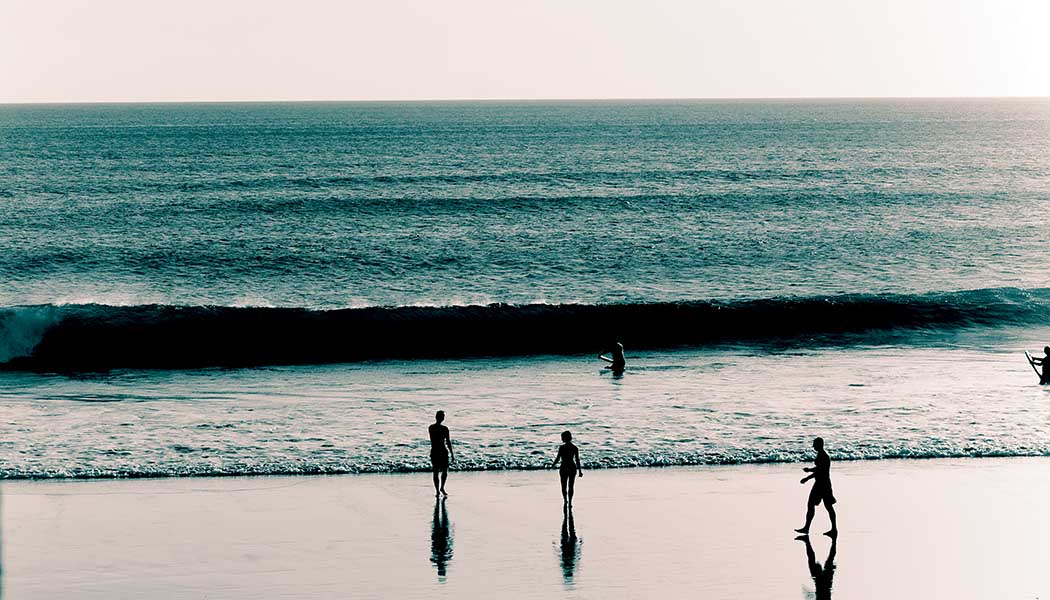Can Bali’s celebrated rain stoppers really stop the rain? Or is a belief in this ancient practice merely the dying fragments of a superstitious, pre-science world? Michael Andrews investigates … and gives it a go himself. Images: Lucky 8.
There’s a misprint in the internet advertisement for a Bali-based company offering the services of a rain stopper. The ad reads, “Brighter the Sky Naturally.” Brighten, surely? Needless to say, it’s a minor slip – similar errors frequently occur with English copy in foreign-speaking countries, sometimes to comic effect. However, for the Balinese rain stoppers themselves, whose livelihood and reputation are based on their ability to communicate directly with the clouds (or by way of the spirits who will move the clouds for them), absolute precision as to the location and time at which a sunny sky is required is essential to success. Provided, of course, that these rain stoppers are able to back up their claims of divine weather control.
The occupation of rain stopper is undeniably close to the top of any directory listing the most unique professions in the world; ahead of comparatively less idiosyncratic occupations such as hot-air balloon pilot, fortune cookie writer, rodeo clown, Braille translator or orchestra page turner.
At the Cloud Nine Chapel, on the grounds of the spectacular St. Regis Hotel in Nusa Dua, among the many choices presented to up-sell the future bride and groom are the inclusion of a “Champagne wedding toast” or the addition of a violin player to the basic “trio-choir” package. Likewise, for an extra US$300, one can reserve the services of a rain stopper. There’s no mention of a disclaimer of responsibility, unlike the accountability-free Chendi Club Wedding Venue in Ubud, where the fine print reads: “The resort cannot be held responsible for the failure of the services provided by a Balinese rain stopper, should you wish to use one.” The St. Regis employs a more politically-correct or, as the sociologist would say, “culturally relative” approach, seductively promising how, “in mystical and magical Bali anything is possible…the Pawang Hujan (i.e. rain stopper) is reputed to make the rain fall anywhere but the location of the celebration.”
Can this be true? Is it possible for someone to be able to stop, move, divert, hold or otherwise charm the rain away from a particular area for a given period of time? And is such God-like intervention somehow more achievable in “magical” Bali? Many local people – both Indonesian and Western expats – would emphatically say: “Yes, it is possible!” And some of them have witnessed the effects first-hand. I recently spoke with event organisers, hotel managers, chefs and others who have seen it happen over and over. Some report miraculous occurrences, where the rain was falling 50 meters away – but not in the designated event areas. Jamie Thewes, former manager of The Istana, marvels over the powers of prominent rain stopper Pak Mangku Ketut Pugrau, whom The Istana has used on 16 occasions during his tenure. All events took place without incurring a drop of precipitation.
As Jamie reports of one function: “It was raining cats and dogs just 20 yards away from the gates. There was literally a visible line on the tarmac. It was downright spooky.”
Hubert Lorenz, who now lives in Germany, recalls similar experiences from years ago when he was the Executive Chef at the Bali Hyatt in Sanur. “The amazing part is that sometimes the rain cleared right on the fence and sometimes it rained as close as the tennis court within the property.” For very important events Lorenz confides that the resort hired two rain stoppers to be doubly sure that rain wouldn’t ruin their event. Furthermore, during the 20-day film shoot of Eat, Pray, Love in Bali, rain stoppers were used daily. Suffice to say, there wasn’t so much of a drizzle in shooting areas for the duration of the movie production.
Skeptics might state – in spite of eyewitness accounts in support of rain stopping successes – that these traditions are simply the dying fragments of a superstitious, pre-science world; traditions which celebrated atheist Christopher Hitchens refers to as a “common trait in all humanity…to meet our inescapable demand for knowledge”. Intellectuals like Hitchens were convinced that such ritualistic dogma points to a time when humanity had a need for understanding that far exceeded the existing grasp of scientific knowledge. Armed with little awareness or comprehension of minutiae such as microscopic cells or particles, nor suitable explanations for the formation of clouds or weather patterns, mankind simply had to try and figure it all out the best it could, and make up the rest as it went along.
Along this train of thought, we can guess that the tradition of rain stopping predates the discovery of the simple scientific explanation of precipitation –water vapour rises higher in altitude to a point where some of the mist becomes cooled enough to form tiny droplets, much smaller than raindrops, that float on other rising air to form clouds; when the water droplets grow heavy enough so as to be subjected to the laws of gravity, they proceed to fall from the sky as rain.
Nassim Nicholas Taleb, the author of Fooled by Randomness (and who familiarised the term “Black Swan” in describing unforeseen events) after years of studying human behaviour, characterises the minds of people, when confronted with things beyond their comprehension, as “wonderful explanation machines, capable of making sense out of almost anything, capable of mounting explanations for all manner of phenomena and generally incapable of accepting the idea of unpredictability.”
Admittedly, it is rather easy for the intellectual mind to dismiss the idea of rain stopping as nonsensical hocus-pocus.Traditionally used in indigenous ceremonies, the ritual is now being applied by enterprising Balinese shaman to serve corporate interests – whether for gala events, golf tournaments, or all-night open-air parties, where a clear night’s sky is essential for a good turnout. The contradictions inherent to this situation are relatively obvious; the thought of a shaman invoking invisible spirits who influence weather patterns and bend the laws of nature (in order to ensure robust liquor sales or to make for a pleasant round of golf, perhaps) would be easy pickings for any late-night-TV talk show host – but that is not my intention here.
In an attempt to provide insight to the believer and non-believer alike, I endeavour to walk a thin line between faith, belief, reality and science in my examination of rain stopping. I will also offer up a glimpse into what I estimate as the mathematical probability of a rain stopper’s success, although hard empirical research is outside the scope of this article.
Throughout this investigation, I have maintained the conviction that it’s not entirely fair to singularly extrapolate rain stopping from the context of the Balinese social-cultural package – even though that is seemingly an authour’s obligation in a report such as this. The real value of this discussion may rest in the ongoing exercise to examine our own beliefs, specifically that murky area where our confirmed knowledge ends and where our faith in the divine or supernatural begins. Where exactly do we draw the line in the sand (or clouds, as it were) between what we will believe in and what we will dismiss as patently absurd?
Articles on rain stopping in some Bali-based magazines have promoted the ritual as unquestionably legitimate. “The success of a rain-diverting ritual can be as high as 90 percent. Compared to modern technology, the use of a traditional rain stopper is much more practical, while its effectiveness is almost certain,” claimed Darma Putra in a piece from the August, 2006 edition of HelloBali.
Sounds simple enough, doesn’t it? A seemingly open-and-shut case in favour of the abilities of a rain stopper, right? The writer does, however, add a cautionary note. “The failure of a rain stopping ritual might occur because several rain stoppers are in action at the same time at a similar location. Each of them will push away the clouds from the area they have to secure, sometimes to the direction where another rain stopping ritual is being held.” For any potential reality-TV producers reading this article, here’s another schlocky idea to please take a pass on: “So you think you can Rain-Stop?” Putra goes on to cite the only other potential reason for failure. “If the ritual of rain stopping is performed too close to the time of rainfall…the better prepared the ritual, the higher chance it will be fulfilled by God.”
But before these ostensibly untested claims make us feel too comfortable or smug in the scientifically-absolute environment of our Western minds, we need to remember that the modern world is still filled with medieval superstitions, old-wives’ tales, myths and unfounded beliefs that haven’t yet disappeared from society – even if we take solace that 200 years have elapsed since the pyre was lit up in West Prussia for the last recorded witch-burning in 1811. To retrieve our humbleness, we need look no further than the common fear of the number 13. The uneasy distress caused by the symbols 1 and 3 put together – while apparently harmless to the Eastern observer – has meant that the plane you arrived on in Bali did not have a seat row 13, and that it’s unlikely that you’ve stayed in a hotel or worked in an office building with a floor numbered 13. In the West we may not have rain stoppers integrated as part of our culture; however, we continue to foster a variety of similar professions with purported abilities of the paranormal, with psychics, UFO hunters, ghost whisperers and astrologists (complete with columns in the daily news); all earning their keep in Western society.
And then there is a nagging old piece of folklore regarding the advancement of Western civilization and how it arose due to the unseen and invisible powers of a “special mind” – one that the people of the West miraculously possessed, but the people of the East apparently did not. Fortunately, facts are now available to debunk this fairy tale, and thanks to works such as Guns, Germs and Steel by Jared Diamond, a study which illustrates a plausible alternative to the supremacist view of human history. To over-simplify his 500-page thesis: Cultures that had limited access to efficient beasts of burden, transportation, with only meager indigenous staple food crops, did not flourish in the same way as cultures that possessed these resources in abundance. A budding society where the available animals were the wildebeest and the llama with crops such as taro and maize could not as easily start up empires of domination. That area of proficiency fell to those peoples with horses, cows, pigs and chickens paired with easily cultivated nutritious grains and high-protein pulses like lentils and chickpeas. It was the latter environment that provided the rich seeds for the development of bigger armies, better weapons, greater power, expanding wealth and, ultimately, the ability to create global empires.
NEEDLESS to say, I wanted to make sure that my Western mind was open enough to the mysteries of the East before I was to meet with a wonderful woman named Tri Harmani and her shining and serene husband, Made Warana, who are a team of married and incredibly successful rain stoppers in Nusa Dua. And if there is one man in Bali who can open even the most skeptical mind over a cappuccino, then Dr. Lawrence Blair is the man.
Dr. Blair has been exploring the mystical in Indonesia ever since 1972, when Ringo Starr gave $4,000 to he and his brother to set sail and make the first documentary of their journeys into previously little-known territories. Some 40 years later, he’s still discovering more. After completing the initial two-time Emmy award winning series Ring of Fire about the unexplained and the fantastical in Indonesia, he went to host another series entitled Myths, Magic & Monsters. Fortunately for Dr. Blair (and unfortunately for us) his are some of the few DVDs that cannot be found pirated in Bali, which means that you’ll need to pay full price for his collections. In the episode entitled Beasts there is footage of a rain stopper/rain maker who works his magic to make it rain on a sunny day with the help of a frog that he places in his mouth. After four hours of meditation with the patient frog firmly between his lips, the rain did finally pour down.
“I’ll say this about the rain stoppers,” relates Dr. Blair, having just returned from guiding another expedition of elite globetrotters around the Malay Archipelago,“they’re very brave. They’ve got to be real brave to tackle the big events, because if they fail to stop the rain for even a few of those, they’re out.”
We went on to discuss a variety of phenomena and studies. He talked about the power of attention in that we can sometimes ‘feel’ when we’re being stared at, or how on occasion we have a sense of who is going to call us just before the phone rings. He mentioned a study showing that dogs can perceive the exact moment when their owners make the mental decision to leave the office and come back home. We talked about how there are many ancient traditions of people who believe that the prevailing weather is a reflection of people’s moods.
He also mentioned Western attempts at ‘cloud bursting’. A scene of this phenomenon was included in the recent release, The Men Who Stare at Goats which Lawrence had not yet seen. Based on real events, the George Clooney film depicts a squadron in the U.S. army that is specially trained to be ‘psychic soldiers’. If this is indeed true – that there were people successfully trained by the U.S. Military to channel energy able to burst apart clouds and to kill goats by staring at them – then rain stopping as a psychic technique begins to gain an air of credibility.
I pushed Lawrence further to get an honest opinion of his belief in rain stopping but he wouldn’t let me off the hook with an easy yes or no answer. The man has seen some unbelievable things over the years and he instead provided me the caveat: “It is always beneficial to believe the ideas of the culture that you live in.”
On that note, I then sat down with Made Warmana and his wife Tri Harmani at their beautiful home in Nusa Dua. They met and married about 10 years ago while they were both learning meditation. Made also performs the art of healing Reiki at the Aman resorts. Although, with Blackberry in hand, Made has the smooth demeanor of a business manager, he and his wife have made spirituality the main focus of their lives. Their shared joy in life is “to help others” and “to spread positive energy to all people”. Made also speaks with a wisdom that reminds one of the books of a Deepak Choprah, Eckhart Tolle and other popular New Age gurus.
“My wife is Catholic and I am Hindu, but we are of the same orientation inside. Just like all people of the different religions on earth, there is no need to talk about what makes us different and our different Gods, but only to talk about what is the common ground to all people and what is the same spirit inside of all people.”
I felt relaxed in the comfort of Made and Tri’s warm presence. I ask him why the Balinese people in particular seem to possess such a spirit of togetherness and friendliness. He replies that “our mutual sense of community and mutual help for each other is part of Tri Hita Karana, an honouring of the three elements of nature: Reverence for God, respect for others and respect for the environment.” He continues: “To become positive as people, it’s not only necessary to speak in the positive, we have to think in the positive and act in the positive.”
Together, he and his wife learned the art of rain stopping from Tri’s father. He says of Tri, who is currently seven months pregnant and will continue her rain stopping practice throughout her pregnancy: “It’s very rare to be a woman and a rain stopper, but Tri has a natural ability.”
Made and Tri are also incredibly careful as to not to cause a major disruption to the ecosystem by their technique and clarifies that “we are not stopping the rain, we are moving it,” preferring the name of “Rain Mover” or even “Rain Charmer”.When they work they trust that the rain will be directed away from where they are asking and directed to such places that need it. He also let me know that they are very careful each time after an event to make sure to give thanks and to help return the weather system back to its normal state.
Made and Tri perform rain stopping rituals for events at The Bvlgari, The St. Regis, The Four Seasons, Aman Resorts and for their own village. Made pulls out his desk calendar and shows me all the bookings, each of which is meticulously marked. Last year, he and Tri performed rain stopping for 97 events.
A day before the event, he or Tri visits the site and synchronise their energy with area’s energy through meditation. They also perform a prayer, making sure to state the exact time the rain needs to be moved. He then fills a small plastic sandwich-bag with sand from the site to take with him. They then go home and begin a fast until the event is over. The next day, during the period of time of the booking, he and his wife will meditate together holding the sand in their hands. He says that if they can feel the sand getting hot, they know it is getting cloudy. Made also relies on phone calls from the staff at the events to keep him informed if there are any clouds coming into the area, so their power can be directed specifically at the incoming clouds.
Over the past year at The Bvlgari, Tri and Made performed their rituals for 65 gala dinners, receptions, weddings and other events. Made and Tri’s ‘cloud informant’ at The Bvlgari is Pak Nana, who works in the Food & Beverage department. During a phone interview, Pak Nana recounts the effects of the ceremony. “It is as if Tri and Made were able to block the rain around the event area with some kind of giant umbrella,” he says. Pak Nana remarks that often the rain would get as close as 50 to 100 metres, without moving any closer. When he sees clouds coming towards the gathering, he calls Made in order to take preventative action. When asked directly as to whether it works or not, he replies: “I believe in it very much. I have seen it.”
Made Warmana explains that the cloud-moving technique he and Tri use is preferred by the hotels mainly for its simplicity and cleanliness. The more traditional Balinese style relies on performing a potentially obtrusive ceremony on site where the spirits are asked to carry out the rain-moving duties. Part of this traditional ceremony not only involves the burning of incense, but can also involve the sacrifice of a chicken. Demonstrably, such extreme measures are something that hotel guests, paying up to US$3,000 per night, don’t want to stumble across during their vacations. By contrast, Made and Tri’s meditation technique involves them simply sitting in a relaxed peace as they synchronise their energies with the area and communicate directly with the essence of the clouds.
Out of Made and Tri’s 97 confirmed engagements last year, only one resulted in rain. This number does not include the numerous times they performed ceremonies for their village and community, usually for free. In fact, Made says that this is his sole failure in 10 years as a rain stopper. In explaining the lone defeat, Made cites not a rival rain stopper at a nearby hotel, but more likely the negative energy of the event staff, who were all hoping for rain in order to get off early from work. In this particular case, he said that he was not called on time when the clouds appeared on site and was therefore unable to engage them successfully until it was too late.
Regardless, a record of at least 96 successful rain-free events against one rained-out event is a seemingly spectacular record. Put this together with other rain movers (like The Istana’s, who has gone 16 in a row) and the evidence begins to mount in favour of their possession of some sort of supernatural ability.
There are also other instances in scientific history where the human mind has been said to influence physical matter. The core idea of quantum theory is that matter does not exist in a distinct objective reality, but based rather on how it is affected by other factors, one of them being the human mind. A famous study by the scientists at the Condensed Matter Physics Department at the Weizmann Institute has become a “golden hen”, which the New Age movement has latched onto as confirmation of the secret that they have felt to be true all along – that thoughts can influence reality.
In the experiment, electrons were passed through areas that were one thousandth of a millimeter in diameter resulting in a wave pattern with no one in the room watching. However, when there was a ‘quantum observer’, a person in the room watching the experiment, the flow of electrons began to switch and behave like linear particles, not like waves. The scientists concluded that the very act of observation was able to influence the behaviour of electrons at a sub-micron level.
If we accept the results of this experiment as fact, then it doesn’t seem all that far-fetched to give credence to the idea that people can learn to influence the movement of water vapour that has condensed in the form of clouds.
However, like other investigations into supernatural activity, the natural rainfall in Bali can be quite deceiving to the casual observer. Although we receive a tremendous quantity of life-nurturing rain every year – the average annual total of approximately 2,000mm dwarfs the 650mm of London– the actual frequency of rain in Bali is much less than other places.Whereas London encounters 145 days of rain and Vancouver averages 163 days, Bali clocks in with the same total as Rome, atroughly 83 rain days per year.
This implies that for 282 days of the year, the chance of success for a rain stopper is 100 percent. Without further statistics, such as the average duration of rainfall, it is difficult to assess a mathematical probability on the days it does rain. But having lived in Bali for some time now, it does feel to me like a rare occasion when the rainfall lasts longer than an hour. When it rains in Bali, it pours – but not for too long. So if we were to figure on the chance of rain during any particular four-hour block of a rain day and allow for an average rainfall duration of one hour, this would mean that the chance of rain occurring on any given 60-minute period would be one in 24 or about four percent. The odds would increase for a four-hour block of time would be 24/4, or 16.7 percent. Allowing for the rain to overlap one minute to up to 59 minutes at either the beginning or near the end of the event would double our odds of escaping drop free to 33.4 percent on a rain day.
To calculate for any given day of the year, to have a four-hour dry period, the odds would be zero percent for 282 clear days and 33.4 percent for the 83 rain days. A weighted average for the year would equate to 7.2 percent chance of rain and 92.9 percent in favour of clear skies. For our rain stoppers, if they were to work on chance alone, this would mean that out of 100 engagements, it would be likely that 92 to 93 would be successful and a mere seven or eight would end up with adverse outcomes. However, during a rainy season month such as January (where there are 16 rain days) our rough calculations would result in an 85 percent chance of sun and a much greater 15 percent likelihood of rain for any four-hour period.
I want to stress that these are by no means exact measurements, as I do not have data which could look at probabilities of rainfall duration at specific times of the day in order to make more accurate estimations. At a rough glance, however, it appears that individual rain stoppers who have many engagements during the rainy season, such as Made and Tri (with a record of 96-1, or 99 per cent) or Pak Mangku (at 16-0, or 100 percent) are in fact beating the odds rather handily.Others who possess the previously reported 90 percent success rate, may not be.

Still, I wondered if rain stopping could be possible. For the purposes of the article I thought I could at least give cloud bursting an honest try. I went down to the beach, found a nice spot, relaxed and supplemented by instructions I had found on the internet, began the cloud bursting technique as demonstrated by George Clooney’s character in the aforementioned movie.
And well…it seemed to work. In fact, the clouds began to disperse a little too easily. I had begun by concentrating on one particular cloud, but instead of anything happening with that one, another cloud nearby broke apart –a sweet victory! There was no way I was going to share this psychic triumph with some rival cloud-busting Jedi sitting somewhere down the beach, all I had do was improve my aim. Moments later, the small cloud I was focusing on finally came undone and was swept into nothingness into the blue sky, but instead of elation, I felt suspicion. If this was all it took, it seemed unrealistically too effortless.
I decided to not focus on anything at all and just observe what was happening up there. Lying on my back, enjoying the enchanting panoramic view of the sky, I watched what transpired. An abundance of different clouds floated above me, and true to form, many of them proceeded to morph together, move apart, break up and disappear altogether – all without my intervention.
Nonetheless, I’m aware this doesn’t prove that it can’t be done by intention, it just seemed to show that nature also takes its own course, with or without our help. We can even become further, excuse the pun, clouded in our judgment by the another feature of ourselves, that being – we as people are not ones to shy away from taking credit for good results when we can, regardless if we had anything to do with them or not.There are numerous psychology studies that point to people mistaking luck or randomness for their own special skills. In one of hundreds of different types of experiments that have been conducted over the years, random lights have been shown to people who have been given a dummy button to press. Time and time again, the people believe that they control the light pattern with their action.
I got up from the spot that may under different circumstances, have had held sacred meaning for me and walked further along the beach. I came upon several thousands of Balinese sitting closely together, some meditating, others sitting quietly and smiling, some being anointed gently by holy water. They were taking part in the melasti ritual which occurs three days before the Balinese day of Silence, Nyepi, the Balinese New Year. Here in Bali, the New Year is brought in, not with the shouts of drunken revelers, but with silent contemplation and meditation done together with family during an enforced day of home-time where not a soul is permitted to walk the streets.
I reflected on agreement with Made Warmana’s words. The Balinese do seem to have produced a culture that promotes togetherness, happiness and openness – characteristics that will be of use to the entire world if humanity is ever going to truly flourish in our increasingly diminutive global village. The art of rain-moving has come out of this highly developed community– based culture, and maybe it’s a lot less important as to whether rain charming actually works than the cultural atmosphere in which it has sprung from.
The Balinese were wise enough to recognise the benefits of using the technologies of the West to enhance their lives, but I wonder if in turn the West will ever exhibit the humility and intelligence to accept the wisdom of the humanness that has been developed and perfected over centuries by the Balinese.
As I continued walking, and continued to think about the differences of East and West, I recalled what Dr. Blair had told me over coffee when I continued to press him for an answer to whether or not he believed. He finally gave up, nonchalantly shrugged his shoulders, and said with a slight sparkle in his crisp British accent: “Well, one thing’s for certain…they couldn’t be any worse than the weathermen.”
Maybe that sums it all up best. If the West still keeps their faith in meteorology in spite of extremely low success rates, then the Balinese are certainly entitled to their rain stoppers.







































